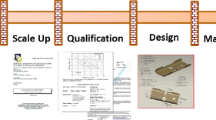Abstract
Continuing efforts to strengthen materials specifications readily recognize that a mere compliance with a materials specification only assures a material meeting or exceeding the minimum expectations explicitly detailed in the specification. Implicitly, such efforts also recognize that additional and specific client needs must be addressed as supplementary requirements and introduced during material procurement to reduce risks and assure enhanced performance. This article describes two U.S. Navy-related case studies that allowed further strengthening of the materials specification process, using newer methods and renewed understanding. The first case demonstrates the use of a constraints-based modeling approach to specify the chemical composition of high-performance welding electrodes for critical U.S. Navy applications. This approach helps to distinguish high-performance welding electrode chemical compositions from rich and lean welding electrode chemical compositions that might limit the operational envelope, reduce performance, or both, while increasing overall cost of fabrication but otherwise meet electrode specification requirements. The second case identifies that the size of an ingot could be an important factor while specifying the aluminum and sulfur contents of very large-size, heavy-gauge plates. Renewed understanding of melt fluidity issues associated with the solidification of very large-size ingots shows that deficiencies in through-thickness ductility of heavy-gauge plates are related to controlling aluminum and sulfur contents of the voluminous melt, notwithstanding explicit compliance with specification requirements.
Similar content being viewed by others
References
“Navy Ships: Lessons of Prior Programs May Reduce New Attack Submarine Cost Increases and Delays,” GAO Report to Congressional Requesters, GAO/NSIAD-95-4, U.S. General Accounting Office, Oct 1994, p 7
K. Sampath, Constraints-Based Modeling Enables Successful Development of a Welding Electrode Specification for Critical Navy Applications, Welding J., Vol 84 (August), 2005, p 131s-138s
“Electrodes and Rods: Welding, Bare, Solid, or Alloy Cored; and Fluxes, Low Alloy Steel,” MIL-E-23765/2E (SH), April 1994
“Specification for Low-Alloy Steel Electrodes and Rods for Gas Shielded Are Welding,” A5.28 American Welding Society, 2005
“Steel Plate, Alloy, Structural, High-Yield Strength (HY-80 and HY-100),” MIL-S-16216K (SH), June 1987
K. Sampath, Meeting Specification, Failing Expectations, Conf. Proc. Use of Bainitic and Bainitic-Martensitic Steels in Current or Developing Applications, Sept. 2004 (New Orleans, LA), MS&T, p 425–432
P.W. Holsberg and R.J. Wong, Welding of HSLA-100 for Naval Applications, in Weldability of Materials, R.A. Patterson and K.W. Mahin, Ed., ASM International, 1990, p 219–239
W. Steven and A.G. Haynes, The Temperature of Formation of Martensite and Bainite in Low-Alloy Steels, J. Iron Steel Inst., Vol 183 (No. 8), 1956, p 349–359
K.J. Irvine and F.B. Pickering, Low-Carbon Bainitic Steels, J. Iron Steel Inst., Vol 184 (No. 12), 1957, p 292–309
W.C. Leslie, The Physical Metallurgy of Steels, McGraw-Hill International Book Co., Kogakusha, Inc., Tokyo, Japan, 1981, p 201–205
N. Yurioka, H. Suzuki, S. Ohshita, and S. Saito, Determination of Necessary Preheating Temperature in Steel Welding, Welding J., Vol 62 (No. 6), 1983, p 147s-153s
R.J. Wong and M.D. Hayes, The Metallurgy, Welding and Qualification of Microalloyed (HSLA) Steel Weldments, American Welding Society, 1990, p 450–489
K. Sampath, R.S. Green, D.A. Civis, H. Dong, and P.J. Konkol, Evaluation of New High-Performance Electrodes for GMA Welding of HSLA-100 Steel, in High Performance Structural Steels, R. Asfahani, Ed., ASM International, 1995, p 179–188
P. Jhaveri, W.G. Moffatt, and C.M. Adams, Jr., The Effect of Plate Thickness and Radiation on Heat Flow in Welding and Cutting, Welding J., Vol 41 (No. 1), 1962, p 12s-16s
Heavy-Gauge Steel Plate Manufacturer’s Report, June 27, 1983, on Testing for Waiver of First Article Inspection Clause in MIL-S-16216J (SH), April 10, 1981, including Amendment 1, August 16, 1982
“NCEMT TR 00-69,” Concurrent Technologies Corporation, Johnstown, PA, 2000
R.W. Heine, C.R. Loper, and P.C. Rosenthal, Principles of Metal Casting, Tata McGraw-Hill Publishing Co., New Delhi, India, 1976, p 414
Author information
Authors and Affiliations
Rights and permissions
About this article
Cite this article
Sampath, K. Strengthening materials specifications. J. of Materi Eng and Perform 14, 596–603 (2005). https://doi.org/10.1361/105994905X64639
Received:
Revised:
Published:
Issue Date:
DOI: https://doi.org/10.1361/105994905X64639




